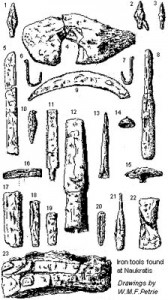Rare meteoritic iron has been found in tombs since the Old Kingdom, but Egypt was late to accept iron on a large scale. It did not exploit any ores of its own and the metal was imported, in which activity the Greeks were heavily involved. Naukratis, an Ionian town in the Delta, became a centre of iron working in the 7th century BCE, as did Dennefeh.
Iron could not be completely melted in antiquity [1], as the necessary temperature of more than 1500°C could not be achieved. The porous mass of brittle iron, which was the result of the smelting in the charcoal furnaces, had to be worked by hammering in order to remove the impurities [2]. Carburizing and quenching turned the soft wrought iron into steel [20]. Iron implements are generally less well preserved than those made of copper or bronze. But the range of preserved iron tools covers most human activities. The metal parts of the tools were fastened to wooden handles either by fitting them with a tang or a hollow socket.
While iron replaced bronze tools completely, bronze continued to be used for statues, cases, boxes, vases and other vessels.
Iron tools found at Naukratis
1, 2, 3 Arrow heads
4 Hoe or adze
5 Knife blade
6, 7 Barbed fishing hooks
8 Borer ?
9 Sickle blade
10 Small point chisel
11 Chisel with tang, for wood
12 Chisel with socket, for wood
13 Borer, socketed
14 Bell ?
15 Scraper ?
16 Double edged pick
17, 18, 19 Chisels for stone or metal
20 Gouge
21 Borer
22 Socketed celt
23 Axe head
